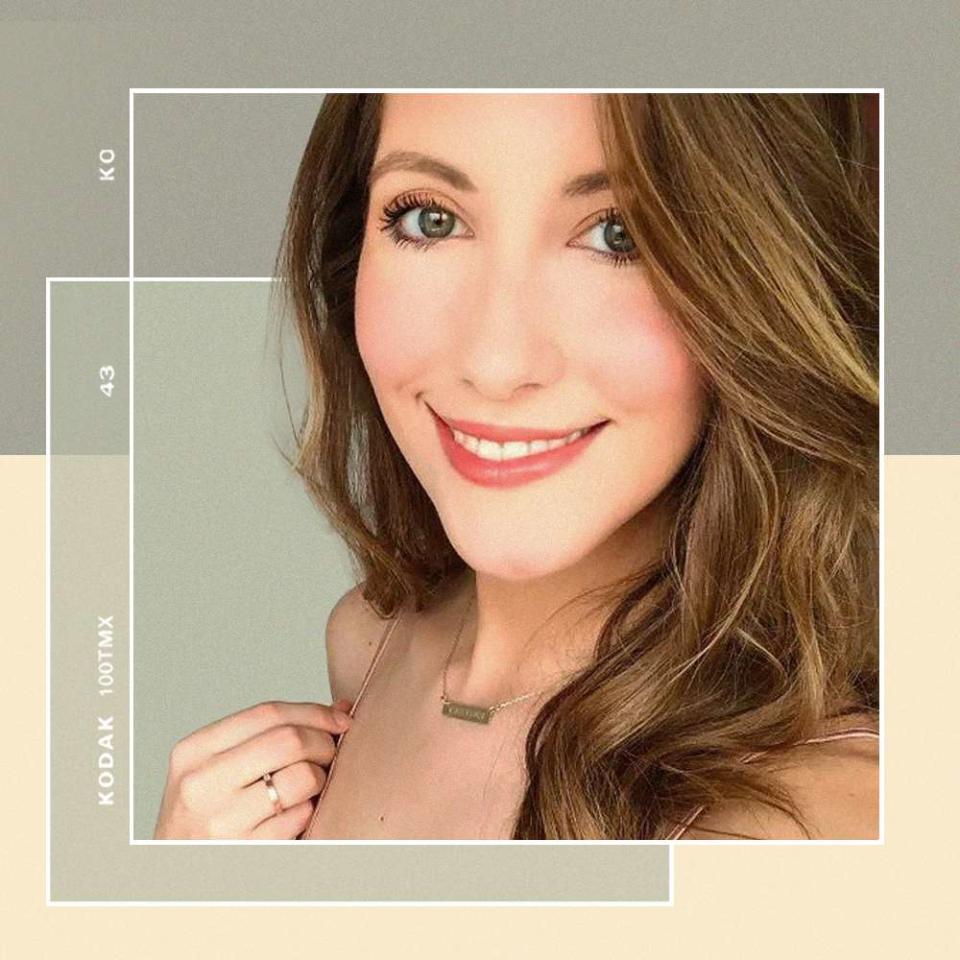I Got Porcelain Veneers—This Is What I Wish I'd Known
How to prep your teeth for the procedure.

Medically reviewed by Victoria Veytsman, DDSFact checked by Anna Harris
Are you wondering why I'm smiling so wide? Well, there's a bit of a backstory there. For as long as I can remember, I've felt self-conscious about my smile — and I was ready for that to change. Lured by the promise of perfectly symmetrical, glossy white teeth in time for my wedding, I made my way to celebrity dentist Dr. Apa, who specializes in teeth veneers. Herewith, I break down the entire process of getting veneers, from prepping my teeth for the procedure to what it cost and how long the veneers will last. Dr. Apa and cosmetic dentist Marc Lowenberg also share their insight on the smile-altering cosmetic treatment. Keep reading to get the lowdown on my smile makeover and more about the veneers process.
Meet Our Experts
Michael Apa, DDS, is a celebrity dentist with international offices and the founder of Apa Beauty, a luxury oral-care cosmetics line.
Dr. Marc Lowenberg is a cosmetic dentist at Lowenberg, Lituchy & Kantor in NYC.
What Are Veneers?
"Veneers are synonymous with a 'smile makeover,' and we have many different tools to get the job accomplished," explains Michael Apa, DDS (the maestro behind my new smile). "Porcelain veneers are traditionally the restoration of choice because they are very conservative to the natural tooth structure. A porcelain veneer, however, is a type of dental restoration like a filling or a crown. Some teeth may need different restorations or even an implant or pre-orthodontia (braces) in order to accomplish the final goal, which is achieving a great smile."
Who Needs Teeth Veneers?
"While some cases are more challenging than others, everyone is a candidate for some type of smile makeover," says cosmetic dentist Dr. Marc Lowenberg. "Someone with dark stained teeth, yellow teeth, crooked teeth, short teeth, a narrow arch, or an aging smile are just some of the things that can be changed."
There are, of course, precautions to take. "If you already have crowns on your teeth, you cannot have veneers replace them," Dr. Lowenberg says. "Also, if you have very little tooth structure left and there is not enough enamel to bond to, then you would have to place a cap or crown rather than a veneer. If you are a habitual tooth grinder, you can still have veneers, but you must sleep with a night guard to prevent breaking the veneers."
The Cost
Now let's talk about the cost of getting veneers. There are a lot of factors that affect the price tag, like your dentist's location and the type of veneers you're getting (composite, porcelain, or ultra-thin porcelain laminates). Composite veneers are the least expensive and can be made in-office, which cuts down on lab fees. These typically cost between $250 and $1,500 per tooth. Porcelain veneers (the kind I got) are sturdier and need to be made in a lab. They cost about $500 to $2,500 per tooth. The laminates, which come from third-party companies, such as Lumineer and Vivaneer, can cost around $800 to $2,000 per tooth. Your dentist will determine which type of veneer is best for you.
Related: I Had a Combination of Gum Contouring, Teeth Whitening, and Veneers to Achieve My Dream Smile
Benefits of Veneers
• Hide imperfections
• Whiter teeth
• More symmetrical smile
Because veneers fit over your actual teeth, they offer the look of a healthy smile, without having to visit an orthodontist or undergo a teeth-whitening procedure. Depending on where they are applied on your teeth, veneers can be used to cover small imperfections (such as a gap between your front teeth) or to completely revamp your smile, making your teeth more symmetrical and ensuring they are glossy white. And because they are fixed to the front of your teeth, veneers can actually improve the tooth structure.
Veneers vs. Dental Bonding
Some candidates for teeth veneers also consider dental bonding, which is a less expensive alternative for a whiter smile. However, veneers and dental bonding aren't exactly the same.
"Bonding entails adhering tooth-colored material directly to the tooth, so your dentist can improve teeth that are chipped, crooked or stained at half the cost of porcelain veneers, resulting in an improved smile at an accessible price," Lowenberg explains. "Bonding is the least invasive procedure in cosmetic dentistry because you do not have to reshape the teeth, you can simply add composite bonding onto the existing tooth. So, for people who don't want their tooth structure touched, you can just use composite bonding to either change the shape of the tooth or change the color of the tooth."
"However," he opines, "porcelain veneers are the best way to replicate natural teeth and achieve a full smile transformation."
What to Expect From the Veneers Process
I visited a bunch of different dentists, one who even suggested we shave my teeth down to little pointed nubs and cover them with crowns (yikes!) I finally made my way to Apa, a serendipitous discovery if I've ever had one. After evaluating my teeth and listening to my own hopes and dreams for them, Apa explained he'd apply veneers on the top and bottom of my teeth (10 on the top and four on the bottom front). This did not involve whittling the teeth down to nothing, but instead removing a bit off the front before placing a veneer about the thickness of a fingernail on top.
"Typically a very small amount of tooth structure is removed to make room for the veneer (we sometimes don't have to remove anything)," says Apa. "Before this step, however, we review the patient's smile to ensure that there is nothing else clinically wrong with the teeth or their bite. For instance, sometimes we use veneer inlays (a porcelain veneer attached to a porcelain filling) for a tooth that needs the facing covered as well as a cavity removed. It really gets into semantics, but most patients I treat are not simply getting straightforward veneers—it's usually a combination because I'm treating the dental disease along with the smile aesthetic."
I was hoping I'd be knocked out cold for the veneers process because nothing gives me the heebie-jeebies like the sound of teeth being filed, but instead I was given local anesthesia and gas. Explains Apa, "You can be [put to sleep], but I personally do not do it because I need my patients to be able to respond to certain things while I'm carrying out the procedure. It's where I carry out the design of their teeth in the temporary phase, and I need to see them moving to be able to make them seamlessly disappear into their face." So I took a deep breath and reassured myself that everything was going to be okay.
During the consult, Apa's assistants took molds of my mouth to create the look of temporary veneers, which are sculpted using a liquid composite. Everything is taken into account when crafting your new smile, from the way you talk to the shape of your face so that it all works together seamlessly. At my next appointment, he applied the temporaries to my teeth (it's a three-hour procedure, as the gums are being shaped and the real teeth underneath are being prepped), which I wore for about a week to test out. Then, I came back, and we discussed any changes I'd like to be made. More molds were taken, and then the final plan was sent to a ceramist to manufacture. The next appointment was around one to two hours wherein the final veneers were bonded to my teeth. Finally, I came back once more for a bite check and final approval.
Side Effects
There will be slight gum sensitivity and pain after the temporaries are put in, but the real pain can occur when you get the final veneers bonded. As I came to learn, some people might experience something referred to as "bonding sensitivity," which feels like that sensation you get when biting into something cold and feeling a sharp pain afterward. I was one of the unlucky ones to feel this intense pain but, thankfully, was given some painkillers to take immediately to curb the sensation. My best advice is to do just as doctor Apa told me: Take painkillers as needed, rinse with warm saltwater, then try to sleep, because trust me, you definitely won't want to be awake for this pain.
The day after the final veneer installation, the pain was gone (thankfully it typically only lasts for the better portion of a day), but my gums were still red and sore from being cut, which you may experience as well. The healing time varies, but it could take a week or so for your gums to return to normal. To aid in the process, you may want to use a gum gel like Apa Pink ($25), a nutrient-rich oral gel meant to nourish and rejuvenate gums. You can also use a mineral rinse meant to strengthen the teeth.
Aftercare
So your new smile is in place, now what? This might come as a rude awakening, but just because you've got veneers doesn't mean proper dental health is no longer required. "Everything can and should be done the same after getting a smile makeover," explains Apa. "If they're done correctly, veneers should act as natural teeth do." And if you get a cavity, Apa explains that in order to drill a cavity on a tooth with veneers, you remove the cavity just as you would a natural tooth and repair with a porcelain filling.
How Long Do Veneers Last?
"In good health, porcelain restorations can last anywhere from 15 to 20 years," says Apa.
"Anything put in your mouth has to be changed, as bacteria and acid will erode the teeth," explains Apa. "That's why it's so important to take care of your teeth, especially if you have a lot of fillings or veneers because you can prolong the lifespan. Another reason veneers need to be replaced is from wear, shifting, and/or gum recession. One thing that sometimes happens is patients will get a full smile makeover and then not follow up with regularly scheduled appointments for years, which are crucial to monitoring their progress. Teeth shift, grinding can occur, and your bite can shift over time, ruining your real teeth or your new, very expensive porcelain ones. Again, this is not just because they have veneers; it's because they're simply not taking care of their mouth in general and need to hit another reset button."
Thankfully, Apa says you do not have to change your eating and drinking habits, so you can continue with red wine and coffee, just drink sparingly (as you should anyway for pearly whites) and remember to consistently floss, brush, and rinse with a fluoride rinse to try to avoid staining and cavities.
"Typically, we say if you take care of your teeth, [veneers] should last up to 20 years," Dr. Lowenberg echoes. "It’s not that they fall off teeth, but they age just like everything else does. It’s not going to look as white and fresh as the day you put them in."
Veneers Before & After
Before

After

The Final Takeaway
We all have our own qualms about our looks. For me, my teeth have always been a pain point. I never had braces growing up (a suggestion never made by my dentist despite some minor crookedness), and their shape was small and a bit jagged. Of course, these are all characteristics that stuck out like a sore thumb to me, but others insisted I was being hard on myself. In any event, I found myself hiding my teeth with my lips when I laughed or giving a meek, close-mouthed smile to strangers. I stopped showing teeth in pictures altogether. And with my wedding coming up in a few months, the anxiety grew about hiding my teeth on arguably the most-photographed day of my life, so I decided to "shop" around for my new smile.
As you can see, the change is pretty dramatic. My smile is brighter and my teeth fill out my mouth much better. In the days following my final veneers appointment, I found myself smiling much bigger and wider, being friendlier, and laughing bigger. They've changed my outlook more than I ever thought possible, and I couldn't be happier.
Up Next: From Strips to LED Lights, We Tested Teeth Whitening Products and Love These 9 Picks
Read the original article on Byrdie.

